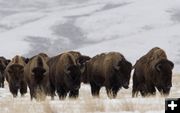

Jackson Bison Herd
A group of bison move onto the National Elk Refuge earlier this fall. Photo by Mark Gocke, WGFD.
|
|
Wildlife Managers seek to control Jackson Bison Herd
Herd 700 animals over desired population objectives
by Wyoming Game & Fish
December 16, 2006
(Jackson) - The three-month hunting season for the Jackson bison herd concluded November 30th, 2006, leaving wildlife managers with continued concerns over the population growth of the herd. While the state established objective calls for a post-hunt population of 400 bison, estimates put the current population at over 1,100 animals. This has state and federal wildlife managers concerned not only for the habitat, but about the potential for increased human conflict as well.
Hunters took 25 cow bison and 23 bull bison this fall season. "Taking 48 animals from a herd of over 1,100 is doing little to curb the growth," says Doug Brimeyer, Jackson Wildlife Biologist for the Wyoming Game and Fish Department. "Overall the herd has been increasing at an annual rate of approximately 15%, so we estimate the herd will increase by another 165 calves or so next spring."
While bison are native to Jackson Hole, they are believed to have been extirpated from the valley between 1830-1880, along with the other 30-60 million bison that once roamed North America. The current Jackson bison herd originated from 16 animals that escaped in the late-1960s from a 1,500 acre enclosure near Moran, called the Jackson Hole Wildlife Park. The park was a private, non-profit enterprise sponsored by the New York Zoological Society, the Jackson Hole Preserve, Inc., and the Wyoming Game and Fish Commission. Since then, most of the herd has found the winter feed lines on the National Elk Refuge and has grown steadily to its current population of more than 1,100 animals.
"The problem is, we currently have an elk herd that is slightly above, but approaching, the 11,000 population objective. When you add a bison herd that is well over the established population objective, you can't help but have impacts to the habitat," says Brimeyer. Because of their size, a bison generally eats on average two to three times what an elk eats.
"We are seeing a dramatic loss of both willow, aspen and cottonwood regeneration on the National Elk Refuge," says Eric Cole, Wildlife Biologist for the National Elk Refuge. "This is a major concern because it impacts so many other wildlife species that utilize these plant communities. The number of bison is also having a large impact on our supplemental feeding program."
Most of the herd spends its summers in Grand Teton National Park and winters on the National Elk Refuge, neither of which allow bison hunting. Both Brimeyer and Cole agree that allowing hunting on the Refuge would help reduce bison numbers. Currently, bison hunting is only allowed on U.S. Forest Service, state and private lands which severely limits hunting opportunities as relatively few bison use these lands.
The National Elk Refuge and National Park Service are in the final stages of completing the interagency Bison and Elk Management Plan and its current 'preferred alternative' would allow bison hunting on portions of the refuge.
"Being able to hunt bison on the refuge is the only way we will ever come close to getting numbers down to the population objective," said Brimeyer. "It would also go a long way towards reducing the bison/human conflicts."
Brimeyer cited examples of bison showing up at Jackson Hole Golf and Tennis and other residential areas north of Jackson, bison goring livestock near Moran and bison frequenting the town of Kelly. "It's one thing to have a deer in your yard, but when it's a 2,000 pound wild animal, there's an obvious human safety threat, and your options to deal with it are limited."
The Final Bison and Elk Management Plan/Environmental Impact Statement is expected to be available to the public in early 2007.
|
